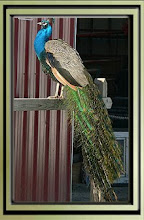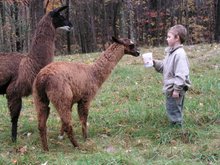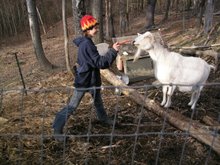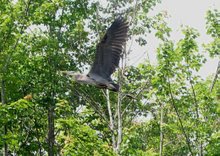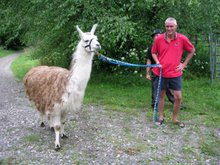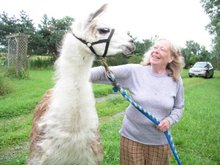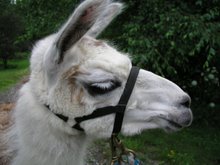When it rains it pours. I really never have understood why we seem to be the busiest, picking up domestics, when spring arrives. You would think that most people would want to get rid of their animals in the fall, so they don't have to feed them all winter. That is not the case with our current recession; spring is busier than usual.
The 19 llamas that came in are doing well and settling in nicely. 6 of the 7 males that were old enough to be gelded were done last week. Dr. Montero and I have done a lot of llama geldings together; we have it down to a science and work together to get it done as quickly as possible without much stress to the animals. I am happy to report that with the generous support of our friends (see our donor list) the vet bill was covered. There is a long road and a lot of expenses still ahead with these llamas. I received an email today from their former owner, she sent me the names of the males--I like to keep original names if possible. They are very grateful that I helped them. I am very glad that all of you helped me. I received some checks from some of the other llama rescue groups in other parts of the USA and that is very flattering. People are validating what we do as a not-for-profit animal rescue and it is coming at a time when we need it the most ... but I will get to that later in this blog.
On Saturday, Shelly Wood organized our second annual Easter Fundraiser. She does all of the advertising, publicity and takes photos of the kids with lambs and baby bunnies that we bring with us. Cheryl Baitsholts and Michele Segerberg (and her daughter Karen) went with me to help out. When we arrived at Teen Town in Cobleskill, a bunch of my high school students were already waiting for us. The weather was beautiful and the Great Horned Owl, Red-tailed hawk and Screech Owl we brought with us enjoyed the weather as much as we did. We enjoyed a great spring day and raised some money to keep the lumber coming for our new Raptor Center.
On Sunday, we met at the Middleburgh Hardware Store where Rich and Heather Vilegi were our gracious hosts. In addition to the great food, Shelly took lots of great pictures. The kids (while they were waiting their turn for photos) actually got to go on an Easter egg hunt around the Hardware Store. Although the weather looked scary, it didn't rain on us, and we had a great crowd out front. The high school Students sold a bunch of raffle tickets, our donation jar did well and Kelly Martin and I shared a different Screech Owl and a Northern Harrier (Marsh Hawk) with many interested people. We raised enough money over the weekend to buy the lumber to work on the Raptor Center this weekend (with our friends from the GE Wildlife Committee).
The phone and emails have been keeping me busy. I am lining up incoming domestics by priority. All of the animals that come here are not always abused, sometimes just unwanted. I went on a pick-up of some animals that were unwanted yesterday. I very rarely get angry at people that want to get rid of their animals. I actually had an animal hoarder tell me that she had read everything that I had ever published and that she was very pleased to finally get to meet me ... as I was at her house climbing over piles of dead animals (with the Humane Society) trying to get the remaining animals off her place during a blizzard. I couldn't be mad at her. She explained through teary eyes that her husband and son had just died. The animals were all she had left and she cried when every one starved to death. She loved them to death.
I actually respect people that know that they are in over their head. They know they are not doing their animals justice and ask for my help before the law has to get involved. Things change for people. They get divorced, find themselves unemployed, have a variety of problems--that does not entitle them to do wrong to their animals. I felt sorry for that old lady but it is criminal that she didn't ask for help before things got that bad for her animals (she wasn't living much better). She loved them so much she cried watching them starve to death. Humans are complex creatures. People need to know when to ask for help and I will always protect their identity and help them if they ask.
I went three hours away for yesterday's rescue. I was suppose to pick up a cow and some sheep that the owner no longer wanted. One of my friends, Justin, went with me for the ride and to give some muscle if needed. I can't do what I used to be able to do when I was 20. We got to the farm and loaded the most pathetic Brown Swiss cow I have ever seen. She is skin and bones and was in a pen with another cow and her calf. "Claire" aborted her calf 3 months premature around 3 weeks ago. I'm not sure if it is from the huge parasite load, ringworm, or her frail condition but she has bigger problems than being a mother right now. She was too weak to stand on the way home but I will fix her up. She isn't too far gone. We put a panel up against her and turned our attention to the 75 +/- sheep that stood crowded in two horse stalls. We were not sure how many sheep we were going to get on the trailer but we started loading them. They are all Shetland and Jacobs, which, luckily, are not big sheep. Justin and I said our goodbyes to the lady and I told her that I would be back soon for the rest of them. We normally stop for some fast food on the trek home, we didn't this trip. We actually didn't stop for fuel, restroom or anything ... we were already working through the game plan for what we were going to do when we got back to our facility.
We got home in record time and decided to start with the sheep. One at a time, we started going through them. Every sheep got wormed and sexed. Since we are not a breeding facility, any sheep that had testicles got neutered on the spot. Turns out that we had 31 sheep on the trailer with the cow. 8 are wethered (neutered) males now, 23 are Ewes or females. Like the cow, they are on the edge of crashing but I know that I will bring them back from the grave. We might lose a couple on the way but it won't be because I am not keeping an eye out for the ones that have given up. Sheep are pretty hard to screw up. Within an hour of being settled in at our facility with several tubs of water and all of the hay they can eat, they act like they own the place. I do have them locked in the courtyard and barn. I am going to have to do several hundred dollars of fence work to keep them quarantined in the lower pasture, because of their small size. I will do that before they get turned out, as I get donations.
Now this is the crazy part: you would think that a guy that just saved a cow and 31 sheep would be happy for a day but I couldn't stop thinking about the ones I left behind. I called the lady to let her know that I had everyone settled in. I had originally planned on going back this weekend to get the rest but I really don't think a lot of them will last that long. I talked to Justin and we are going back tomorrow afternoon to get the rest of the cows and sheep. I know that I can't help every animal in the world. I don't have the money or the time but I can help these 3 cows and 75 sheep. They are in real bad shape but will come back to life with some good food, a worming routine and ample pasture. I will have the shearer come in May to get them cleaned up at the same time as the llamas. They will get their tails banded then, too. Thank God that it isn't fly season yet or these sheep would be eaten alive by maggots. They will eventually be adoptable; a lot of people like Jacobs and Shetland sheep because they are small and easy to handle. It will cost around $25- a sheep to get them fixed up. Your donations are always put to good use here.
We have crossed the bridge with the llamas but now we are knee deep in sheep. I will let you know how we make out tomorrow. I know I will sleep better tomorrow night when I can walk out to the barn and refill hayracks.
Please tell your friends about what we do, I appreciate your support more than words can express.
Till next time, all my best,
Wes
Please also see our other blog at
http://nywildliferescue.blogspot.com/
It is more active than this one. Always check there for updates, too.
Northeast Llama Rescue was started by Wes and Darcy Laraway of Middleburgh, NY.
Several years ago they rescued their first llama out of a tiny horse pen. Since that day, Northeast Llama Rescue has helped dozens of Camelids from several different states. The primary mission of Northeast Llama Rescue is to educate owners on how to properly care for their animals.
We also offer assistance with a traveling chute to shear, worm, and trim toenails on hard to handle animals. A 'TRUE REPUTABLE BREEDER" should help out the llama down the road that is not being cared for by owners that understand the needs of llamas.
If you know of a llama owner who is no longer able to care for their animals, there is help available. Members of Northeast Llama Rescue will adopt any unwanted animals. Rescue animals will be relocated to farms of members for training and necessary vet work.
If a llama is able to be rehabilitated, he will be available after a careful screening process. All rescues are placed in homes with a contract that says they shall be provided for and can not be sold. In the event a rescue animal becomes unwanted, the llama MUST be returned to Northeast Llama Rescue.
If you share our philosophy and love for the animals, you are more than welcome to join us! There are lots of llamas that need a person to love.
We also rescue farm animals, and are licensed wildlife rehabilitators.
This site is copyrighted by Wes Laraway.
Wednesday, April 1, 2009
Subscribe to:
Posts (Atom)
Northeast Llama Rescue by Wes Laraway
The Northeast Llama Rescue was started by Wes and Darcy Laraway several years ago after they rescued their first llama out of a tiny horse pen. Since that day, the Northeast Llama Rescue has helped dozens of animals in 5 states. The primary mission of Northeast Llama Rescue is to educate owners on how to care for their animals properly. We also offer assistance with a traveling chute to shear, worm and trim toenails on hard to handle animals. If owners get "tired" of the daily maintenance of their herds, members of the Northeast Llama Rescue will adopt or buy, if possible, any unwanted animals. Rescue animals go to the farms or members of the organization.
The Northeast Llama Rescue does not wish to compete with other rescue organizations, although any llama or alpaca is welcome. We need to cooperate to help ALL camelids, not just registered or "nice-looking" ones. Everyone has the right to breed and sell llamas, but a true reputable breeder will "help out" the llama down the road that is not being cared for, regardless of its age, sex or conformation.
Our last rescue came from Central New York. A farm had purchased 9 animals from a Midwest auction. Four of the animals had died from natural causes....starvation? The owner had health problems and no longer wanted the animals. After several other concerned people failed to negotiate their sale, I eventually called and within five minutes we had agreed on a price and the deal was done. The next night, Wes Laraway, Kim Scheurerman and P.J. Wagner went to pick up the animals. The owner informed us that the llamas were wild and could not be handled. Within five minutes all were calmly caught, on lead ropes and in the trailer, with us using a wand and some TEAM Training techniques. The owner thought I was the "llama whisperer" because I got those llamas to do things in five minutes that she couldn't do in a year. She unfortunately knew nothing about handling llamas.
Three hours later, we were back into quarantine at Red Maple Farm starting "damage control". The animals were immediately wormed, fed fresh hay and grain, and watered. All were body scored under three by sight and by feeling through their wool. This hands-on inspection revealed barbed wire that needed to be cut out of the fiber. We decided NOT to shear because it was too late in the year and they were too thin.
Another concern was an ingrown halter. One of the best ways to remove ingrown halters is to undo the buckle(s) and cut the nose band with sharp toenail clippers on each side of the nose. Then gradually, over time, the remaining pieces will fall out. With application of an antibiotic cream, any wounds from the ingrown halter will heal quickly. In this particular case, the halter came out of the nose and was added to the "wall of shame" in our barn (along with the barbed wire and ear tags still on them from the auction they were purchased from). The blood stream stopped within fifteen minutes and now, after a month, we can tell that scarring will be minimal. Please tell everyone you know that owns camelids, NEVER leave a halter on a llama! Even in a week, with wet conditions, a halter can embed itself in a llama's nose.
My biggest concern was the 10 month old female that was exposed to her father. If bred, we decided to abort the unborn cria for the safety and well-being of the young female. None of these five animals were over the age of three years. All of them, over the following months, would need intense care and proper nutrition. The animals were all updated on health requirements and gelded. All of these animals would need training before they could go up for adoption.
New problems continuously arose. Two weeks after they arrived, one of the females surprised us with a weak, constipated fourteen pound male cria. Within hours I knew it wasn't "normal" so mom and baby were moved to a quarantine pen in the barn. The decision was made to supplement the cria with goat colostrum and give him an enema. Although the cria was walking, he continued to strain to relieve himself. Around the clock surveillance did not reveal any nursing or defecation. At two days old, I found very small maggots between the cria's toes and by his umbilical cord. After consulting my vet again, the cria got a bath and dried out in the heated office before going back to mom in the barn. My vet explained that crias born on rainy days must be completely dry or flies will lay eggs in moist areas of umbilical fluid. I've never heard of this problem before but I know now to check my newborn crias for maggots every day. After five days of constant care, we lost "Trooper"....I guess it was not meant to be, but we tried.
The rest of the animals are doing well today. Concerned individuals found them, bought them and will protect them. Today is actually a special day, because the vet did fecals on them and all five of them are parasite free and can join our llama herd. After training and further rehabilitation, by Spring 2001 this group of animals will be available for adoption to carefully approved homes. All animals sold or placed by Northeast Llama Rescue will be adopted with a legal contract. The contract states that if the llama ever becomes unwanted or is not cared for properly, the animal will return to Red Maple Farm for a full refund. I used to think I could save every unwanted llama in the world...I know that I can't . It is too great an undertaking for one farm to rescue all the unwanted camelids out there. For this reason, several other farms have joined in the effort with Red Maple Farm to pool resources and save neglected and unwanted camelids.
Any farm that shares our philosophy that every llama deserves a life with proper care is welcome to join us. We are people who genuinely love all llamas and want to make a difference one llama at a time. Eventually we will print an educational brochure to hand out at events with member farms listed. Don't just tell people that you love your llamas; show people by making a difference and actually save one. Always quarantine new animals for at least one month while getting wormings, vaccines and nutritional needs in order. Always do a fecal exam and consult your vet about when new animals should go out with the herd. Geld all males and most of all BE PATIENT. Llamas are very forgiving animals and will learn to love and trust again with gentle care and training.
The Northeast Llama Rescue does not wish to compete with other rescue organizations, although any llama or alpaca is welcome. We need to cooperate to help ALL camelids, not just registered or "nice-looking" ones. Everyone has the right to breed and sell llamas, but a true reputable breeder will "help out" the llama down the road that is not being cared for, regardless of its age, sex or conformation.
Our last rescue came from Central New York. A farm had purchased 9 animals from a Midwest auction. Four of the animals had died from natural causes....starvation? The owner had health problems and no longer wanted the animals. After several other concerned people failed to negotiate their sale, I eventually called and within five minutes we had agreed on a price and the deal was done. The next night, Wes Laraway, Kim Scheurerman and P.J. Wagner went to pick up the animals. The owner informed us that the llamas were wild and could not be handled. Within five minutes all were calmly caught, on lead ropes and in the trailer, with us using a wand and some TEAM Training techniques. The owner thought I was the "llama whisperer" because I got those llamas to do things in five minutes that she couldn't do in a year. She unfortunately knew nothing about handling llamas.
Three hours later, we were back into quarantine at Red Maple Farm starting "damage control". The animals were immediately wormed, fed fresh hay and grain, and watered. All were body scored under three by sight and by feeling through their wool. This hands-on inspection revealed barbed wire that needed to be cut out of the fiber. We decided NOT to shear because it was too late in the year and they were too thin.
Another concern was an ingrown halter. One of the best ways to remove ingrown halters is to undo the buckle(s) and cut the nose band with sharp toenail clippers on each side of the nose. Then gradually, over time, the remaining pieces will fall out. With application of an antibiotic cream, any wounds from the ingrown halter will heal quickly. In this particular case, the halter came out of the nose and was added to the "wall of shame" in our barn (along with the barbed wire and ear tags still on them from the auction they were purchased from). The blood stream stopped within fifteen minutes and now, after a month, we can tell that scarring will be minimal. Please tell everyone you know that owns camelids, NEVER leave a halter on a llama! Even in a week, with wet conditions, a halter can embed itself in a llama's nose.
My biggest concern was the 10 month old female that was exposed to her father. If bred, we decided to abort the unborn cria for the safety and well-being of the young female. None of these five animals were over the age of three years. All of them, over the following months, would need intense care and proper nutrition. The animals were all updated on health requirements and gelded. All of these animals would need training before they could go up for adoption.
New problems continuously arose. Two weeks after they arrived, one of the females surprised us with a weak, constipated fourteen pound male cria. Within hours I knew it wasn't "normal" so mom and baby were moved to a quarantine pen in the barn. The decision was made to supplement the cria with goat colostrum and give him an enema. Although the cria was walking, he continued to strain to relieve himself. Around the clock surveillance did not reveal any nursing or defecation. At two days old, I found very small maggots between the cria's toes and by his umbilical cord. After consulting my vet again, the cria got a bath and dried out in the heated office before going back to mom in the barn. My vet explained that crias born on rainy days must be completely dry or flies will lay eggs in moist areas of umbilical fluid. I've never heard of this problem before but I know now to check my newborn crias for maggots every day. After five days of constant care, we lost "Trooper"....I guess it was not meant to be, but we tried.
The rest of the animals are doing well today. Concerned individuals found them, bought them and will protect them. Today is actually a special day, because the vet did fecals on them and all five of them are parasite free and can join our llama herd. After training and further rehabilitation, by Spring 2001 this group of animals will be available for adoption to carefully approved homes. All animals sold or placed by Northeast Llama Rescue will be adopted with a legal contract. The contract states that if the llama ever becomes unwanted or is not cared for properly, the animal will return to Red Maple Farm for a full refund. I used to think I could save every unwanted llama in the world...I know that I can't . It is too great an undertaking for one farm to rescue all the unwanted camelids out there. For this reason, several other farms have joined in the effort with Red Maple Farm to pool resources and save neglected and unwanted camelids.
Any farm that shares our philosophy that every llama deserves a life with proper care is welcome to join us. We are people who genuinely love all llamas and want to make a difference one llama at a time. Eventually we will print an educational brochure to hand out at events with member farms listed. Don't just tell people that you love your llamas; show people by making a difference and actually save one. Always quarantine new animals for at least one month while getting wormings, vaccines and nutritional needs in order. Always do a fecal exam and consult your vet about when new animals should go out with the herd. Geld all males and most of all BE PATIENT. Llamas are very forgiving animals and will learn to love and trust again with gentle care and training.




